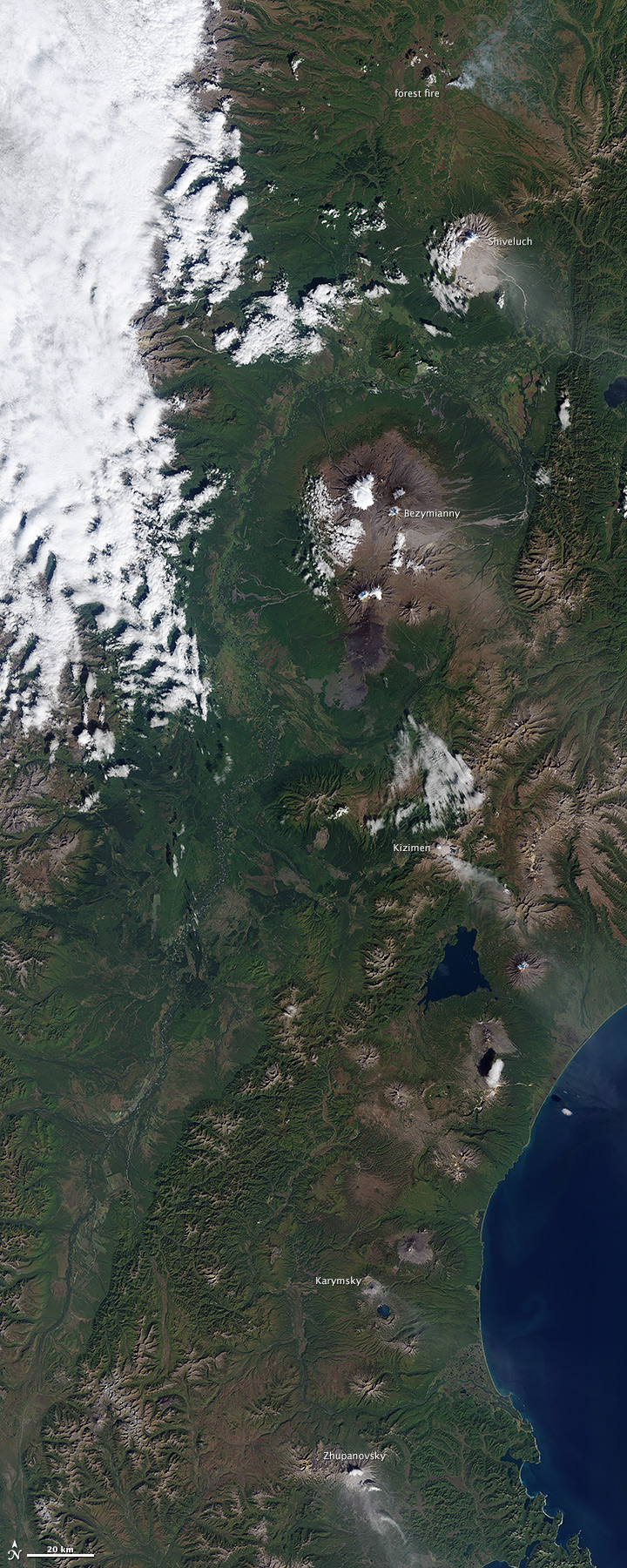
Volcanoes of Kamchatka
Downloads
- kamchatka_oli_2014255_lrg.jpg (6240x18719, JPEG)
- kamchatka_oli_2014255_geo.tif (12475x37424, GeoTIFF)
- kamchatka_oli_2014255.kml (KML)
Metadata
- Sensor(s):
- Landsat 8 - OLI
- Data Date: September 12, 2014
- Visualization Date: September 24, 2014
In 1996, when the United Nations was considering whether to add the volcanoes of the Kamchatka Peninsula to its list of World Heritage sites, the committee was asked to consider what made those volcanoes more worthy of preservation than the many others around the world. At the time, several volcanoes were already on the list, and three others were under consideration.
The answer was reminiscent of something that explorer Stepan Krasheninnikov pointed out in 1755. “Perhaps there is no other region in the world where so many volcanoes and hot springs are to be found in so small a space as here on Kamchatka,” he wrote in Description of Kamchatka Land. Indeed, the peninsula’s location on the Ring of Fire puts it in one of the most geologically active zones on the planet. There are more than 300 volcanoes on the Kamchatka peninsula, including 29 that are active.
But Kamchatka’s volcanoes are remarkable for more than their numbers. “Geologists classify volcanoes by form and by eruptive habits,” the nominators wrote, “and once again Kamchatka stands out as having the greatest variety of types, more so than any other area and than in any other existing World Heritage site.”
Thanks to clear weather on September 12, 2014, the Operational Land Imager (OLI) on Landsat 8 captured a series of images that showcases the geologic diversity of Kamchatka’s volcanoes. This mosaic includes six scenes stitched together from the September 12 flyover.
From geographic north to south, the erupting volcanoes are Shiveluch, Bezymianny, Kizimen, Karymsky, and Zhupanovsky. Several volcanoes were erupting simultaneously, sending faint plumes of ash and gas drifting southeast. Smoke from a wildfire burning north of Shiveluch is also visible.
The tallest of the group is Shiveluch, a steep-sloped stratovolcano, that reaches 3,283 meters (10,771 feet) above sea level. The most active is Karymsky, a 1,536-meter (5,039-foot) peak that has erupted regularly since 1996. The Shiveluch and Bezymianny eruptions are both characterized by growing lava domes—thick, pasty lava that forms a mound as it is extruded. Kizimen’s lava is not as viscous as that at Shiveluch and Bezymianny. The intermediate lava forms thick, blocky flows bordered by tall levees. Rocks and ash frequently fall from Kizimen’s summit and the fresh lava flow on its eastern flank, creating dark, fan-shaped debris deposits.
Kamchatka’s volcanoes are also defined by their inaccessibility. Fewer than 350,000 people live on the peninsula, with most of them in Petropavlovsk-Kamchatsky. Broad swaths of the peninsula lack roads, and helicopters are the only way to get around in some areas.
The logistical challenges associated with installing and maintaining ground-based sensors make satellites a necessity for monitoring Kamchatka’s volcanoes. “There are several volcanic phenomena that lend themselves to remote detection and monitoring: eruption plumes laden with ash, sulfur dioxide, and water; low-temperature anomalies such as crater lakes and fumaroles; high-temperature anomalies, such as lava flows, pyroclastic flows, and lava domes; and deformation of the volcanic edifice,” explained Michael Abrams, a NASA scientist and the leader of the ASTER science team, in a chapter of the Encyclopedia of Remote Sensing.
References and Related Reading
Abrams, M. (2014) Volcanism. Encyclopedia of Remote Sensing, 890-893.
- Earth Observatory (2010, December 6) Kamchatka Volcanoes.
- Global Volcanism Program Kamchatka and Mainland Asia. Accessed September 23, 2014.
- Kamchatka Volcanic Eruption Response Team (2014, September 23) Kamchatka and the Northern Kuriles volcanoes: Erupting or Restless. Accessed September 23, 2014.
- PBS The Ring of Fire. Accessed September 23, 2014.
- United Nations Organization for Education, Science and Culture Volcanoes of Kamchatka. Accessed September 23, 2014.
- United Nations Organization for Education, Science and Culture (1996) World Heritage Nomination: Volcanoes of Kamchatka. Accessed September 23, 2014.
NASA Earth Observatory image by Jesse Allen, using Landsat data from the U.S. Geological Survey. Caption by Adam Voiland
This image record originally appeared on the Earth Observatory. Click here to view the full, original record.